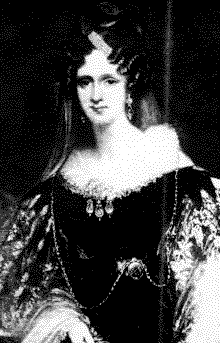You are using an out of date browser. It may not display this or other websites correctly.
You should upgrade or use an alternative browser.
You should upgrade or use an alternative browser.
William IV (1765-1837) and Adelaide of Saxe-Meiningen (1792-1849)
- Thread starter saxon
- Start date
If you have answers, please help by responding to the unanswered posts.
She was William IV's wife. As the Duke of Clarence he lived with an actress, Dorothy Jordan, for many years, and they had something like ten children. When Princess Charlotte, the only direct heir to the throne, died in childbirth, some of the Prince of Wales's brothers were made to find themselves wives and produce some heirs to the throne, so William married Adelaide of Saxe-Meiningen in 1819. All their children were stillborn or lived a very short time, so the throne went to William's niece Victoria when he died in 1837. Queen Adelaide lived another 10 years or so after that and died in 1849.
http://www.regiments.org/biography/royals/1792adel.htm
http://www.regiments.org/biography/royals/1792adel.htm
mybags
Courtier
- Joined
- Apr 14, 2003
- Messages
- 661
- City
- San Diego
- Country
- United States
Queen Adelaide was still very much a part of the royal family after King William's death. She attended many events with the new Queen, her niece, and Prince Albert, as well as her sister-in-law, the Duchess of Kent.
tiaraprin
Royal Highness
- Joined
- Feb 21, 2004
- Messages
- 1,824
- City
- Near NY City
- Country
- United States
After Queen Victoria married Albert, she embraced Queen Adelaide but only shook hands with her mother the Duchess of Kent. The relations between mother and daughter at that time were still chilly due to the Conroy situation.
She was not considered beautiful, but she was a warm-hearted woman. It was also sad for her to lose all her children during their infancy or early childhood. It also couldn't have been easy dealing with William IV with his loud, colorful language. I think this is where George V got it from, William IV!!
She was not considered beautiful, but she was a warm-hearted woman. It was also sad for her to lose all her children during their infancy or early childhood. It also couldn't have been easy dealing with William IV with his loud, colorful language. I think this is where George V got it from, William IV!!
Last edited by a moderator:
Harry's polo shirt
Heir Presumptive
- Joined
- Jul 25, 2005
- Messages
- 2,084
- City
- my paradise
- Country
- United States
I think these are her...
1. http://www.homeoint.org/morrell/articles/pm_brita.htm
2. http://www.touradelaide.com/
1. http://www.homeoint.org/morrell/articles/pm_brita.htm
2. http://www.touradelaide.com/
Attachments
tiaraprin
Royal Highness
- Joined
- Feb 21, 2004
- Messages
- 1,824
- City
- Near NY City
- Country
- United States
That is her Harry!! Good Work!!!!
tiaraprin
Royal Highness
- Joined
- Feb 21, 2004
- Messages
- 1,824
- City
- Near NY City
- Country
- United States
I have begun to think about what would Queen Adelaide say about the happenings with today's Royal Family??
Australian
Heir Presumptive
- Joined
- Aug 22, 2004
- Messages
- 2,149
- City
- Perth
- Country
- Australia
I often think about that too tiarapin. I also wonder what she would think as well as Victoria, Elizabeth I, Mary I+2, William, George etc about the current goings on. I am sure they are probably not too happy about the Charles/Camilla marriage. Maybe a bit disappointed in all the divorces of the Queens children and sister. But then again, those past monarchs were not squeaky clean too, For example Henry VIII and his divrces and beheadings, Elizabeth I and her consent to kill her cousin.
Last edited:
tiaraprin
Royal Highness
- Joined
- Feb 21, 2004
- Messages
- 1,824
- City
- Near NY City
- Country
- United States
I think Elizabeth I was backed into a corner on that one. She refused for many years to not shed the blood of her cousin and of an anointed Queen. Mary, Queen of Scots was a potent threat to Elizabeth I. Whether the information about Mary's activities were lies or accurate, Elizabeth I acted on what she had to do to protect her throne. She didn't even read the writ of execution. She told her courtiers to mix it up in the papers and she just went through signing without reading any of the documents in that pile. Elizabeth was quite overwrought with what she had to do. Mary's own son didn't even protest her execution. He was too busy coveting the crown of England.
Last edited by a moderator:
iowabelle
Royal Highness , Royal Blogger, TRF Author
- Joined
- Jul 19, 2005
- Messages
- 2,403
- City
- Des Moines
- Country
- United States
Then again, William IV and George IV were rival candidates for the title of "royal wild child." Just think, if Charles had followed the example of George IV, he could have snuck Camilla off and married her on the sly... and then marry some other woman officially.
Some of these ancestors -- even more recent ones -- eren't examples of moral rectitude.
Some of these ancestors -- even more recent ones -- eren't examples of moral rectitude.
Last edited by a moderator:
tiaraprin
Royal Highness
- Joined
- Feb 21, 2004
- Messages
- 1,824
- City
- Near NY City
- Country
- United States
No they weren't.
Queen Adelaide's husband, William IV, was living with a famed actress named Dorothy Jordan for 20 years and had 10 children with her. When George IV's heir, Princess Charlotte died, there was a new incentive to having a proper marriage and children. William rudely dumped Dorothy Jordan penniless (and she supported him through her acting jobs) and told her if she returned to acting her children would be taken away. Dorothy had to return to acting to survive, and the children were taken. Dorothy died a pauper's death.
This is the man Queen Adelaide married. I don't know how she put up with him!!
Queen Adelaide's husband, William IV, was living with a famed actress named Dorothy Jordan for 20 years and had 10 children with her. When George IV's heir, Princess Charlotte died, there was a new incentive to having a proper marriage and children. William rudely dumped Dorothy Jordan penniless (and she supported him through her acting jobs) and told her if she returned to acting her children would be taken away. Dorothy had to return to acting to survive, and the children were taken. Dorothy died a pauper's death.
This is the man Queen Adelaide married. I don't know how she put up with him!!
Last edited by a moderator:
iowabelle
Royal Highness , Royal Blogger, TRF Author
- Joined
- Jul 19, 2005
- Messages
- 2,403
- City
- Des Moines
- Country
- United States
tiaraprin said:This is the man Queen Adelaide married. I don't know how she put up with him!!
I wonder if her family made her, after all, she was just one of the lesser German princesses. I've never heard anything about that. But none of the sons in that generation were prizes.
I always had the feeling that Queen Victoria's mother had to marry the Duke of Kent for financial reasons since she was widowed with two young children.
Warren
Administrator in Memoriam
- Joined
- Jan 22, 2005
- Messages
- 15,447
- City
- Sydney
- Country
- Australia
The race to the altar
Perhaps none of the sons were prizes, but the possibility of a Queen Consort's Crown, or being mother of a future Monarch, was certainly a glittering incentive!
Perhaps none of the sons were prizes, but the possibility of a Queen Consort's Crown, or being mother of a future Monarch, was certainly a glittering incentive!
Last edited:
tiaraprin
Royal Highness
- Joined
- Feb 21, 2004
- Messages
- 1,824
- City
- Near NY City
- Country
- United States
Adelaide was not William IV's first choice. He had proposed to a couple of other princesses who did reject him with their family's approval. William was desperate to get married and Adelaide of Saxe-Meinigen was a "spinster" princess at the age of 26. She, not wanting to remain a spinster, and the possibility of having a child who would succeed to the throne, led her to accept William. She couldn't completely foretell she would be Queen because Frederick, The Duke of York, was still alive then but childless. His wife was barren.


Last edited by a moderator:
Ygraine
Commoner
- Joined
- Mar 25, 2006
- Messages
- 26
- City
- The Best
- Country
- Australia
Adelaide is one of my favourite people.She was by all accounts a gentle ,kind and warm woman who after losing several children of her own including stillborn twins was in no way bitter and doted on her niece Victoria I also am fairly sure I read that she had very good relationships with her stepchildren a sweet ,sweet woman who when she first arrived in England had some very nasty remarks made about her appearance especially her skin her husband came to depend on her greatly
Paula**
Courtier
- Joined
- Mar 7, 2005
- Messages
- 655
- City
- Lisbon
- Country
- Portugal
This forum is also culture 
I've never seen anything about her before
I've never seen anything about her before
felicia
Aristocracy
- Joined
- Dec 9, 2005
- Messages
- 160
- City
- Brisbane
- Country
- Australia
I am a big fan of Queen Adelaide. She had seven children, including a set of twins, but all died in infancy. Only two were named - Charlotte Augusta Louisa (lived for one day) and Elizabeth Georgiana Adelaide who lived from December 1820 to March 1821. She was a very nice Queen and was quite close to her niece Queen Victoria.
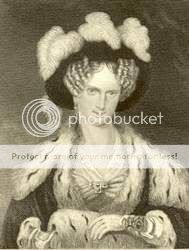
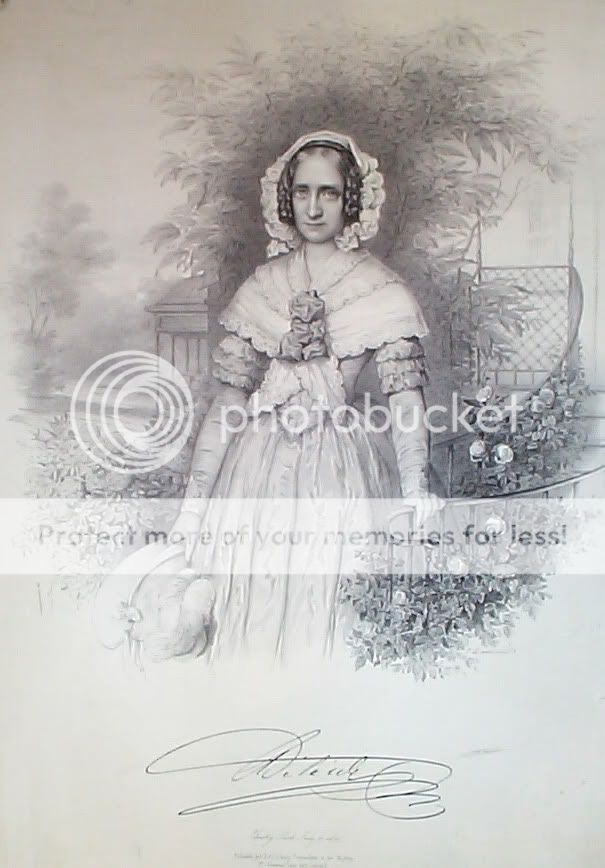


Last edited:
felicia
Aristocracy
- Joined
- Dec 9, 2005
- Messages
- 160
- City
- Brisbane
- Country
- Australia
Queen Adelaide
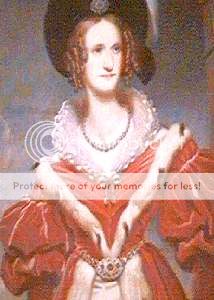
.
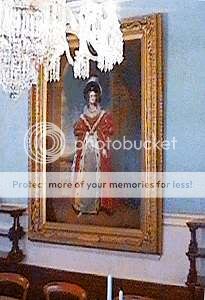 .
.
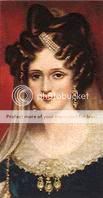 .
.
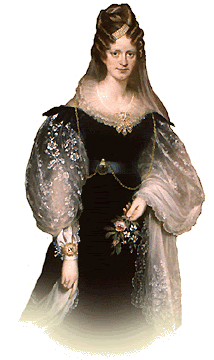
.
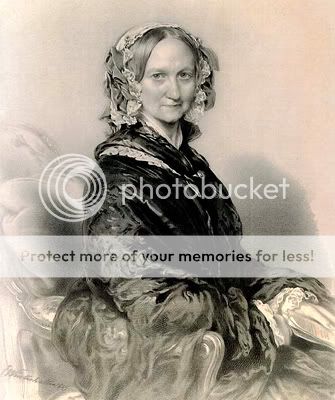
She was the eldest daughter and child of the Duke and Duchess of Saxe-Meiningen;
Her full name was Adelaide Louise Theresa Caroline Amelia
courtesy: http://users.chariot.net.au/~sah/adelaide.htm

.



.

She was the eldest daughter and child of the Duke and Duchess of Saxe-Meiningen;
Her full name was Adelaide Louise Theresa Caroline Amelia
courtesy: http://users.chariot.net.au/~sah/adelaide.htm
Last edited by a moderator:
felicia
Aristocracy
- Joined
- Dec 9, 2005
- Messages
- 160
- City
- Brisbane
- Country
- Australia
In 1818, when Her Majesty was the Duchess of Clarence and St Andrews . . . . . The Dowager Queen Adelaide in 1849
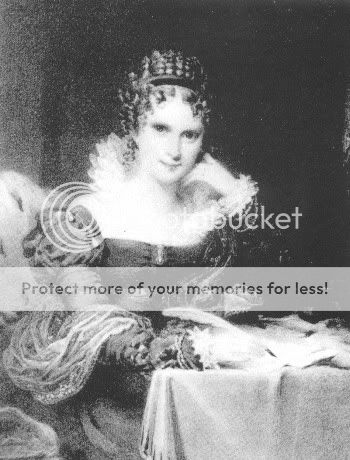 . . .
. . .
.
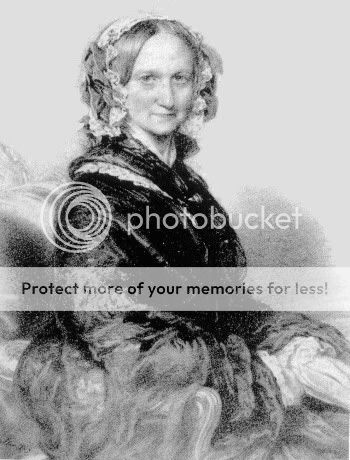
The Dowager Queen Adelaide in 1849
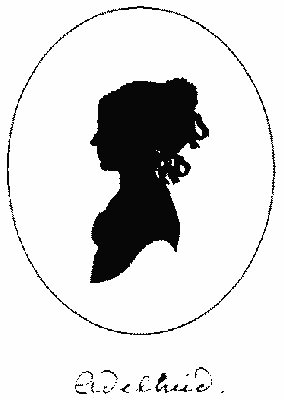 .
.
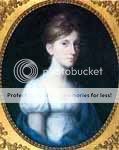 .
.
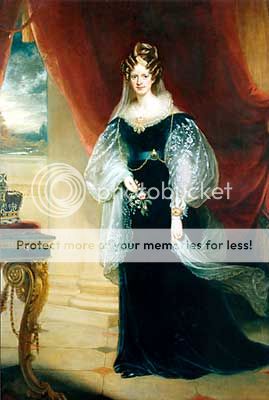
.
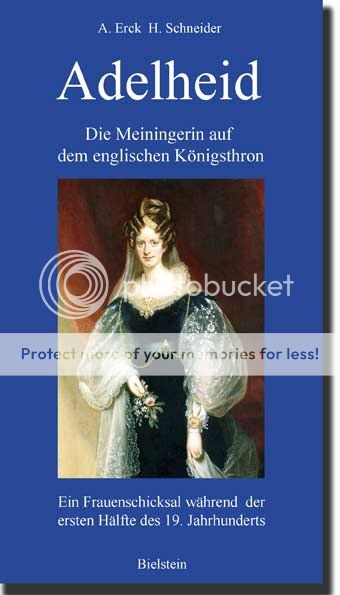 .
.
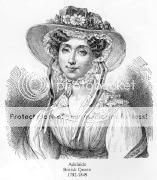 .
.
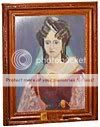 .
.
.
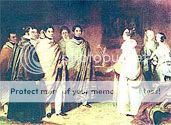 . .
. .
. .
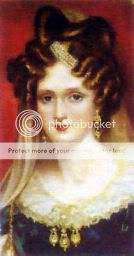

.

The Dowager Queen Adelaide in 1849



.



.

. .

Last edited by a moderator:
felicia
Aristocracy
- Joined
- Dec 9, 2005
- Messages
- 160
- City
- Brisbane
- Country
- Australia
Queen Adelaide married King William IV on the 11th July 1818 before he was king.
Queen Adelaide was the eldest daughter of the Duke of Saxe-Meiningen. William IV was King of Great Britain (1830 - 1837)
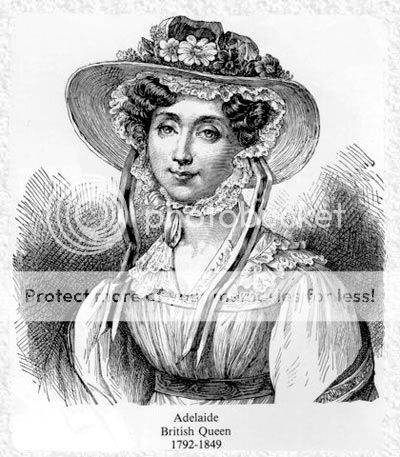
1831 CORONATION JUG QUEEN ADELAIDE.
Size: 5 1/2" tall
A VERY UNUSUAL QUEEN ADELAIDE 5 1/2"JUG. PRODUCED ABOUT THE TIME OF THE CORONATION OF KING WILLIAM IV AND QUEEN ADELAIDE. A DETAILED NAMED PORTRAIT WITH PLUMED HEADPIECE. THE BACKGROUND HAS BIRDS AND FOLIAGE. SOME WEAR TO THE GLAZE ON THE LIP AND THE HANDLE. THIS RARE PIECE IS SOUND WITH NO CHIPS, CRACKS OR RESTORATION.
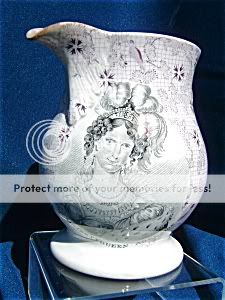
.
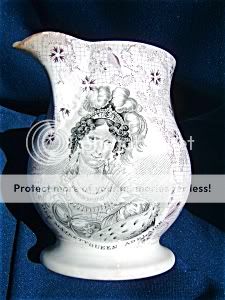 .
.
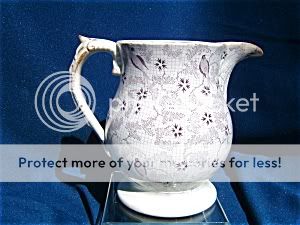 .
.
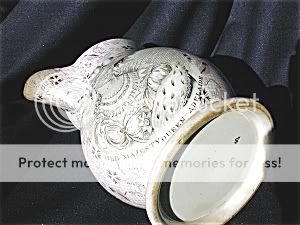
Queen Adelaide Wine in Australia
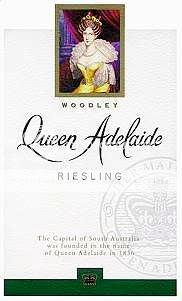
COMMEMORATIVE JUG KING WILLIAM AND QUEEN ADELAIDE 1831
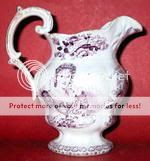
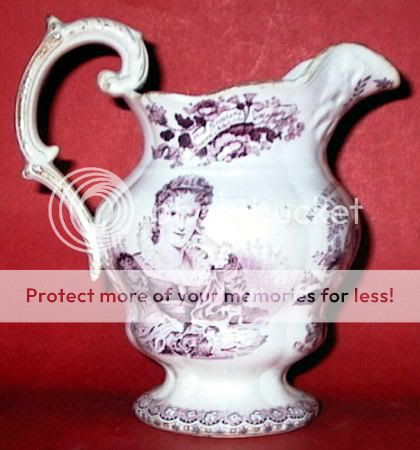 .
.
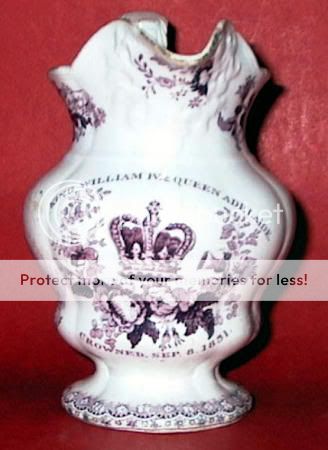 .
.
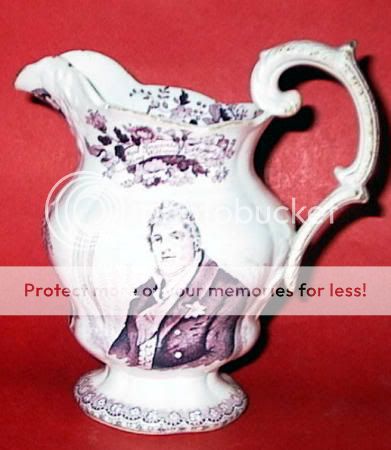
Jugs pics from: Antique and Collectible Mall: TIAS.com: Antiques and Collectibles
Queen Adelaide was the eldest daughter of the Duke of Saxe-Meiningen. William IV was King of Great Britain (1830 - 1837)

1831 CORONATION JUG QUEEN ADELAIDE.
Size: 5 1/2" tall
A VERY UNUSUAL QUEEN ADELAIDE 5 1/2"JUG. PRODUCED ABOUT THE TIME OF THE CORONATION OF KING WILLIAM IV AND QUEEN ADELAIDE. A DETAILED NAMED PORTRAIT WITH PLUMED HEADPIECE. THE BACKGROUND HAS BIRDS AND FOLIAGE. SOME WEAR TO THE GLAZE ON THE LIP AND THE HANDLE. THIS RARE PIECE IS SOUND WITH NO CHIPS, CRACKS OR RESTORATION.

.



Queen Adelaide Wine in Australia

COMMEMORATIVE JUG KING WILLIAM AND QUEEN ADELAIDE 1831




Jugs pics from: Antique and Collectible Mall: TIAS.com: Antiques and Collectibles
Last edited by a moderator:
felicia
Aristocracy
- Joined
- Dec 9, 2005
- Messages
- 160
- City
- Brisbane
- Country
- Australia
[FONT=Arial, Verdana, Geneva]Queen Adelaide receiving the Malagasy ambassadors at Windsor Castle in March 1837[/FONT]
[FONT=Arial, Verdana, Geneva]Color photograph of an oil-on-canvas painting by the British painter Henry Room (1802-1850)
Crown © U.K. Government Art Collection
[/FONT][FONT=Arial, Verdana, Geneva]Courtesy Government of the Republic of Madagascar[/FONT]
[FONT=Arial, Verdana, Geneva]
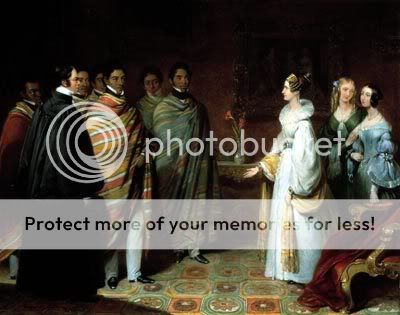 [/FONT] .[FONT=Arial, Verdana, Geneva]
[/FONT] .[FONT=Arial, Verdana, Geneva]
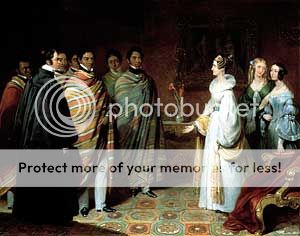 [/FONT]
[/FONT]
[FONT=Arial, Verdana, Geneva]Color photograph of an oil-on-canvas painting by the British painter Henry Room (1802-1850)
Crown © U.K. Government Art Collection
[/FONT][FONT=Arial, Verdana, Geneva]Courtesy Government of the Republic of Madagascar[/FONT]
[FONT=Arial, Verdana, Geneva]


Last edited by a moderator:
felicia
Aristocracy
- Joined
- Dec 9, 2005
- Messages
- 160
- City
- Brisbane
- Country
- Australia
RARE c.1831 KING WILLIAM IV AND QUEEN ADELAIDE PLATE.
Size: 7 3/4 - This plate was issued around the time of the Coronation of William IV in 1831. The molded rim portraits of William and Adelaide are hand-enameled. One of a series of plates issued with a variety of decorations in the center. The red-brown transfer print is decorated in green and yellow and entitled, "The Hen in the Flower Garden". In sound condition for a piece over 170 years old with no chips or cracks. There in wear to the rim, all over crazing with some resulting discoloration. For similar plates see ‘Victoria Remembered’ by John May page 11.
pics courtesy: http://pages.theroyalpavilion.com
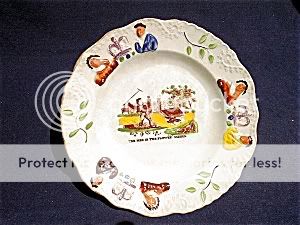 .
.
 .
.
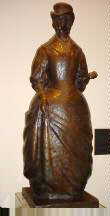
William IV and Queen Adelaide standing by an altar. PROCLAIMED JUNE 28 1830
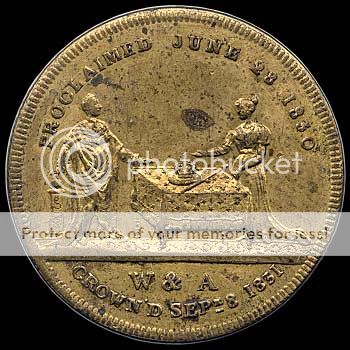 .
.
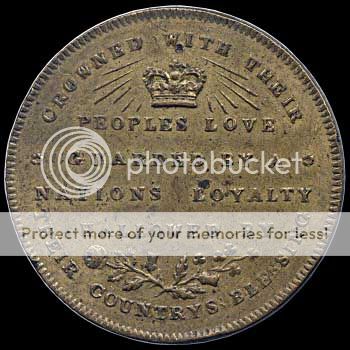
CROWNED WITH THEIR / PEOPLES LOVE / GUARDED BY A / NATIONS LOYALTY / HALLOWED BY / THEIR COUNTRY'S BLESSING. Crown with rays below first line; sprays of rose, thistle and shamrock above last line.
Document 79952
QUEEN ADELAIDE. AQS: "A Reg" as Queen of England, 1p, 3½x4¼, mounted to a page of similar size. In full: "Commit thy way unto/the Lord, trust also/in Him and he shall/bring it to pass". Headed "Ps XXXVII.5" indicating it is a biblical quote from Psalms 37:5. Adelaide (1792-1849) and William, Duke of Clarence, third son of King George III, were married on July 11, 1818. In 1830, upon the death of his brother, King George IV, William became King William IV and his wife became Queen Adelaide. They had seven children (including twin girls), but five were stillborn, and the other two died before reaching the age of two. When King William IV died in 1837, his niece succeeded him on the British throne as Queen Victoria. Soiled. Lightly creased from mounting.
Correction: they had twin boys, not girls.
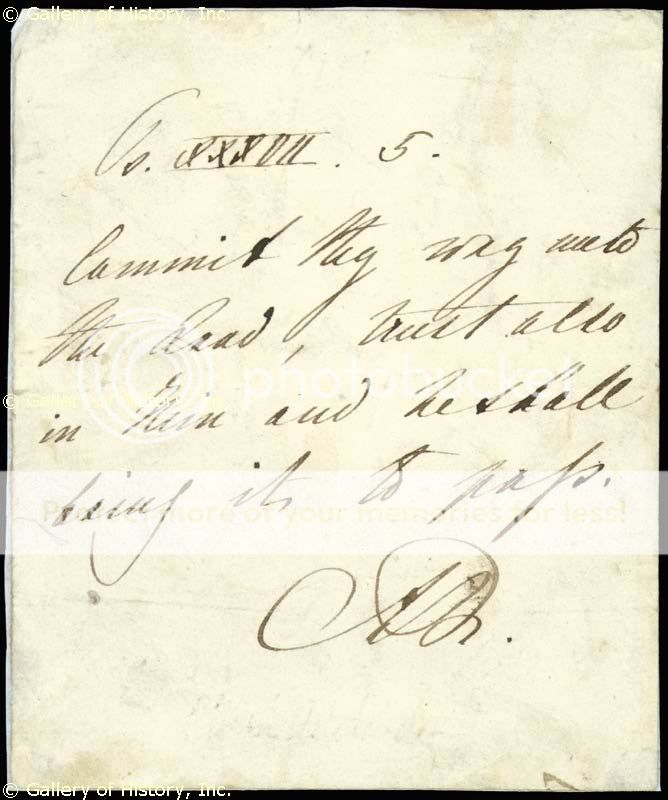 . . .
. . .

The State Diadem
This fantastic piece of jewellery, made in diamonds and pearls, was executed on the orders of King George IV and was it possibly worn by him at his coronation, over a large plumed hat. Some sources, nevertheless, say the King never wore it, for the diadem was judged too feminine. The circular diadem is decorated with four crosses-pattées, set with diamonds, representing St. George, the front one with a wonderful honey-coloured diamond in the centre. The four bouquets of flowers in diamonds include roses, thistles and shamrocks, representing England, Scotland and Ireland. Wales, being a principality, was not represented. Below, two rows of pearls with diamonds in the middle make it one of the finest pieces of jewellery of the royal collection. It is part of the Crown Jewels since the death of HM Queen Victoria, who left it to the Crown in her will. The diadem was never used by a male royal again, only by queens, consorts and regnant, from Queen Adelaide to Queen Elizabeth II.
pics courtesy: http://www.angelfire.com/realm2/coronation/dress.html
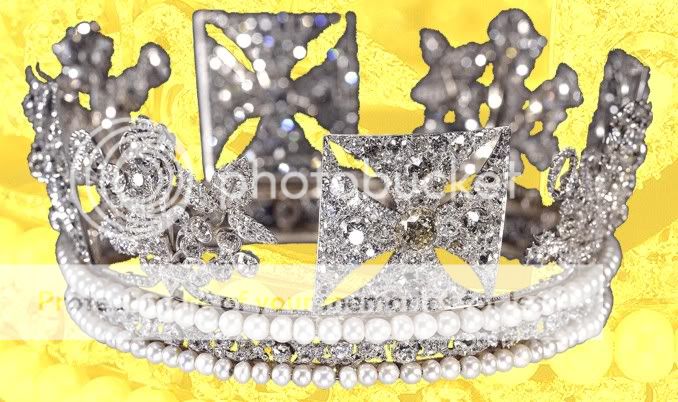
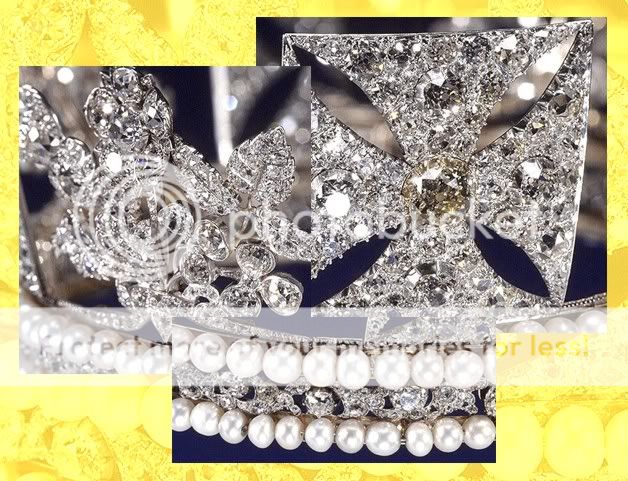
Some details of the State Diadem.
Large Dining Room - Government House, Adelaide, South Australia
The Large Dining Room was added during the second stage of construction. Up to twenty eight people may be seated for dinner. Formal dinners of about this number are held regularly. Note portrait of Queen Adelaide on right.
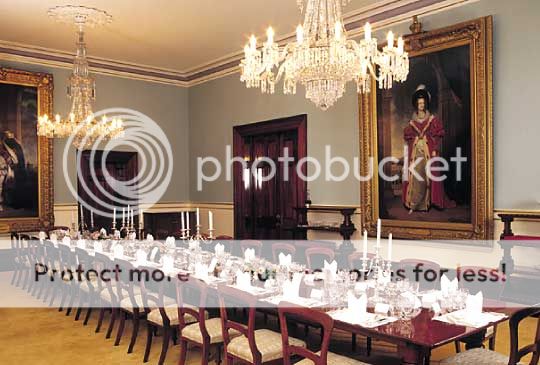
[FONT=Arial, Helvetica, sans-serif][SIZE=-1]The portraits in this room are of King William IV and Queen Adelaide. The portrait of William IV was listed in the 1868 inventory. Three cedar serving tables of four shelves grace the room. [/SIZE][/FONT]
[FONT=Arial, Helvetica, sans-serif][SIZE=-1]The dining table is of mahogany and is dated 1850-1900. The chairs are in a semi balloon-back style. [/SIZE][/FONT]
pic courtesy: http://www.governor.sa.gov.au/html/govhouse.html
Size: 7 3/4 - This plate was issued around the time of the Coronation of William IV in 1831. The molded rim portraits of William and Adelaide are hand-enameled. One of a series of plates issued with a variety of decorations in the center. The red-brown transfer print is decorated in green and yellow and entitled, "The Hen in the Flower Garden". In sound condition for a piece over 170 years old with no chips or cracks. There in wear to the rim, all over crazing with some resulting discoloration. For similar plates see ‘Victoria Remembered’ by John May page 11.
pics courtesy: http://pages.theroyalpavilion.com



William IV and Queen Adelaide standing by an altar. PROCLAIMED JUNE 28 1830


CROWNED WITH THEIR / PEOPLES LOVE / GUARDED BY A / NATIONS LOYALTY / HALLOWED BY / THEIR COUNTRY'S BLESSING. Crown with rays below first line; sprays of rose, thistle and shamrock above last line.
Document 79952
QUEEN ADELAIDE. AQS: "A Reg" as Queen of England, 1p, 3½x4¼, mounted to a page of similar size. In full: "Commit thy way unto/the Lord, trust also/in Him and he shall/bring it to pass". Headed "Ps XXXVII.5" indicating it is a biblical quote from Psalms 37:5. Adelaide (1792-1849) and William, Duke of Clarence, third son of King George III, were married on July 11, 1818. In 1830, upon the death of his brother, King George IV, William became King William IV and his wife became Queen Adelaide. They had seven children (including twin girls), but five were stillborn, and the other two died before reaching the age of two. When King William IV died in 1837, his niece succeeded him on the British throne as Queen Victoria. Soiled. Lightly creased from mounting.
Correction: they had twin boys, not girls.


The State Diadem
This fantastic piece of jewellery, made in diamonds and pearls, was executed on the orders of King George IV and was it possibly worn by him at his coronation, over a large plumed hat. Some sources, nevertheless, say the King never wore it, for the diadem was judged too feminine. The circular diadem is decorated with four crosses-pattées, set with diamonds, representing St. George, the front one with a wonderful honey-coloured diamond in the centre. The four bouquets of flowers in diamonds include roses, thistles and shamrocks, representing England, Scotland and Ireland. Wales, being a principality, was not represented. Below, two rows of pearls with diamonds in the middle make it one of the finest pieces of jewellery of the royal collection. It is part of the Crown Jewels since the death of HM Queen Victoria, who left it to the Crown in her will. The diadem was never used by a male royal again, only by queens, consorts and regnant, from Queen Adelaide to Queen Elizabeth II.
pics courtesy: http://www.angelfire.com/realm2/coronation/dress.html


Some details of the State Diadem.
Large Dining Room - Government House, Adelaide, South Australia
The Large Dining Room was added during the second stage of construction. Up to twenty eight people may be seated for dinner. Formal dinners of about this number are held regularly. Note portrait of Queen Adelaide on right.

[FONT=Arial, Helvetica, sans-serif][SIZE=-1]The portraits in this room are of King William IV and Queen Adelaide. The portrait of William IV was listed in the 1868 inventory. Three cedar serving tables of four shelves grace the room. [/SIZE][/FONT]
[FONT=Arial, Helvetica, sans-serif][SIZE=-1]The dining table is of mahogany and is dated 1850-1900. The chairs are in a semi balloon-back style. [/SIZE][/FONT]
pic courtesy: http://www.governor.sa.gov.au/html/govhouse.html
Last edited by a moderator:
felicia
Aristocracy
- Joined
- Dec 9, 2005
- Messages
- 160
- City
- Brisbane
- Country
- Australia
Queen Adelaide
Born: 13 AUG 1792, Meiningen, Thuringia, Germany
Acceded: 8 SEP 1831, Westminster Abbey, London, England
Died: 2 DEC 1849, Bentley Priory,Stanmore,Middlesex
Interred: St.George's Chapel,Windor Castle,England
Father: Saxe-Meiningen, George I of, Duke of Saxe-Meiningen, b. 4 FEB 1761
Mother: Hohenlohe-Langenburg, Louisa Eleonora of, Princess, b. 11 AUG 1763
Married 13 JUL 1818, Kew Palace, Surrey to Hanover, William IV Henry, King of Britain
Child 1: Hanover, Child, b. 1818
Child 2: Hanover, Charlotte Augusta Louisa, b. 21 MAR 1819
Child 3: Hanover, child, b. 5 SEP 1819
Child 4: Hanover, Elizabeth Georgiana Adelaide, b. 10 DEC 1820
Child 5: Hanover, Child, b. 23 APR 1822
Child 6: Hanover, Twins, b. 1824
Information on Queen Adelaide's page on the Royal GEDCOM Database.
http://www3.dcs.hull.ac.uk/cgi-bin/gedlkup/n=royal?royal00219
For more information about Adelaide's namesake, Queen Adelaide, please download the following brochure:
.
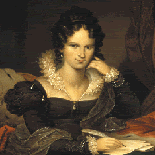 . http://www.adelaidecitycouncil.com/archives/pdf/queenadelaide.pdf
. http://www.adelaidecitycouncil.com/archives/pdf/queenadelaide.pdf
PDF File about the life and times of HM Queen Adelaide with lots of pictures.
Saxe-Meiningen, Adelaide Louisa Theresa.

PDF File about the life and times of HM Queen Adelaide with lots of pictures.
Born: 13 AUG 1792, Meiningen, Thuringia, Germany
Acceded: 8 SEP 1831, Westminster Abbey, London, England
Died: 2 DEC 1849, Bentley Priory,Stanmore,Middlesex
Interred: St.George's Chapel,Windor Castle,England
Father: Saxe-Meiningen, George I of, Duke of Saxe-Meiningen, b. 4 FEB 1761
Mother: Hohenlohe-Langenburg, Louisa Eleonora of, Princess, b. 11 AUG 1763
Married 13 JUL 1818, Kew Palace, Surrey to Hanover, William IV Henry, King of Britain
Child 1: Hanover, Child, b. 1818
Child 2: Hanover, Charlotte Augusta Louisa, b. 21 MAR 1819
Child 3: Hanover, child, b. 5 SEP 1819
Child 4: Hanover, Elizabeth Georgiana Adelaide, b. 10 DEC 1820
Child 5: Hanover, Child, b. 23 APR 1822
Child 6: Hanover, Twins, b. 1824
Information on Queen Adelaide's page on the Royal GEDCOM Database.
http://www3.dcs.hull.ac.uk/cgi-bin/gedlkup/n=royal?royal00219
Last edited by a moderator:
felicia
Aristocracy
- Joined
- Dec 9, 2005
- Messages
- 160
- City
- Brisbane
- Country
- Australia
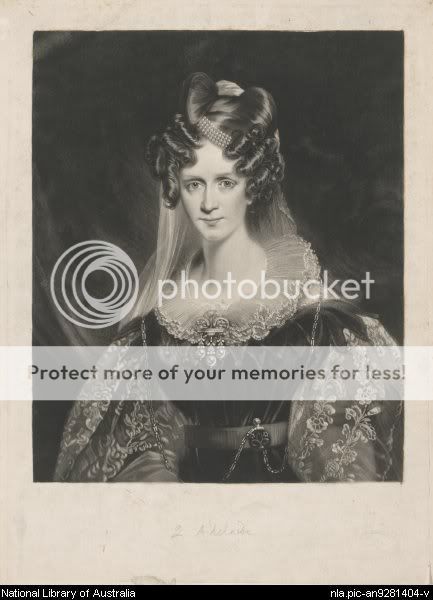
Sitter - Adelaide Amelia Louisa Theresa Caroline of Saxe-Coburg Meiningen (1792-1849), Queen of William IV. Sitter in 16 portraits.
Artist - Sir William Beechey (1753-1839), Portrait painter. Artist associated with 119 portraits, Sitter in 5 portraits.
[FONT=Arial,Helvetica]
The eldest daughter of George, Duke of Saxe-Coburg Meiningen, Adelaide married William, Duke of Clarence in 1818, and became queen on his accession to the throne as William IV in 1830. In this portrait, which is a version of Beechey's full-length of the queen in evening dress, she wears a blue velvet dress with white lace ruff and sleeves. Her pearl tiara rests on her elaborately coiffured hair and she wears an exquisite pendant brooch with matching earrings. The locket on a chain fixed to her belt is likely to contain a portrait miniature.

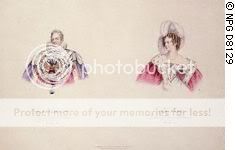
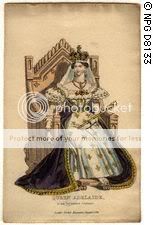
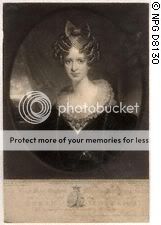
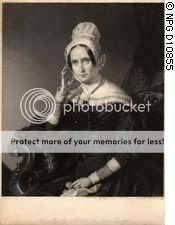
..
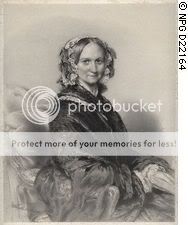
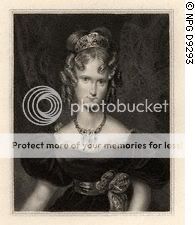
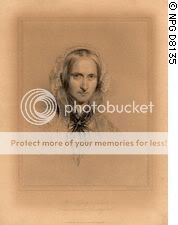

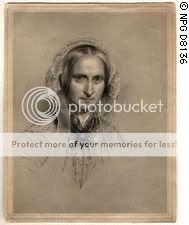
Last edited by a moderator:
felicia
Aristocracy
- Joined
- Dec 9, 2005
- Messages
- 160
- City
- Brisbane
- Country
- Australia
Queen Adelaide and Prince William, Duke of Clarence later King William IV were married at the same time in a double ceremony with William's brother Prince Edward, Duke of Kent and Princess Victoire or Victoria, later Duchess of Kent, and Queen Victoria's mother.
Judiciously, in the circumstances, neither of the brides was in her first youth, the future Queen Adelaide having been, at twenty-six, the younger of the two. The Duchess of Kent, a little over thirty, had been already married, in 1803, when she was seventeen, to Prince Emich Charles of Leiningen. Eleven years afterwards, in 1814, she was left a widow with a son and daughter. Four years later she married the Duke of Kent. The brides were very different in looks and outward attractions. The Duchess of Clarence, with hair of a peculiar colour approaching to a lemon tint, weak eyes, and a bad complexion, was plain. She was also quiet, reserved, and a little stiff, while she appears to have had no special accomplishments, beyond a great capacity for carpet-work. The Duchess of Kent, with a fine figure, good features, brown hair and eyes, a pretty pink colour, winning manners, and graceful accomplishments—particularly music, formed a handsome, agreeable woman, “altogether most charming and attractive.”
But both Duchesses were possessed of qualities in comparison with which beauty is deceitful and favour is vain—qualities which are calculated to wear well. Queen Adelaide's goodness and kindness, her unselfish, unassuming womanliness and devout resignation to sorrow and suffering, did more than gain and keep the heart of her bluff, eccentric sailor-prince. They secured for her the respectful regard of the nation among whom she dwelt, whether as Queen or Queen-dowager. The Archbishop of Canterbury could say of her, after her husband's death, “For three weeks prior to his (King William's) dissolution, the Queen sat by his bedside, performing for him every office which a sick man could require, and depriving herself of all manner of rest and refection. She underwent labours which I thought no ordinary woman could endure. No language can do justice to the meekness and to the calmness of mind which she sought to keep up before the King, while sorrow was pressing on her heart. Such constancy of affection, I think, was one of the most interesting spectacles that could be presented to a mind desirous of being gratified with the sight of human excellence.” [Footnote: Dr. Doran] Such graces, great enough to resist the temptations of the highest rank, might well be singled out as worthy of all imitation.
Judiciously, in the circumstances, neither of the brides was in her first youth, the future Queen Adelaide having been, at twenty-six, the younger of the two. The Duchess of Kent, a little over thirty, had been already married, in 1803, when she was seventeen, to Prince Emich Charles of Leiningen. Eleven years afterwards, in 1814, she was left a widow with a son and daughter. Four years later she married the Duke of Kent. The brides were very different in looks and outward attractions. The Duchess of Clarence, with hair of a peculiar colour approaching to a lemon tint, weak eyes, and a bad complexion, was plain. She was also quiet, reserved, and a little stiff, while she appears to have had no special accomplishments, beyond a great capacity for carpet-work. The Duchess of Kent, with a fine figure, good features, brown hair and eyes, a pretty pink colour, winning manners, and graceful accomplishments—particularly music, formed a handsome, agreeable woman, “altogether most charming and attractive.”
But both Duchesses were possessed of qualities in comparison with which beauty is deceitful and favour is vain—qualities which are calculated to wear well. Queen Adelaide's goodness and kindness, her unselfish, unassuming womanliness and devout resignation to sorrow and suffering, did more than gain and keep the heart of her bluff, eccentric sailor-prince. They secured for her the respectful regard of the nation among whom she dwelt, whether as Queen or Queen-dowager. The Archbishop of Canterbury could say of her, after her husband's death, “For three weeks prior to his (King William's) dissolution, the Queen sat by his bedside, performing for him every office which a sick man could require, and depriving herself of all manner of rest and refection. She underwent labours which I thought no ordinary woman could endure. No language can do justice to the meekness and to the calmness of mind which she sought to keep up before the King, while sorrow was pressing on her heart. Such constancy of affection, I think, was one of the most interesting spectacles that could be presented to a mind desirous of being gratified with the sight of human excellence.” [Footnote: Dr. Doran] Such graces, great enough to resist the temptations of the highest rank, might well be singled out as worthy of all imitation.
Last edited:
felicia
Aristocracy
- Joined
- Dec 9, 2005
- Messages
- 160
- City
- Brisbane
- Country
- Australia
Signature of Queen Adelaide with R for Regina (Queen)
source: http://www.manuscripts.co.uk/stock/20527.HTM

ADELAIDE, Queen (1792-1849). Consort of William IV.
Large signature ('Adelaide R' with a flourish)
More Jugs, etc. with Queen Adelaide portraits
 .
.
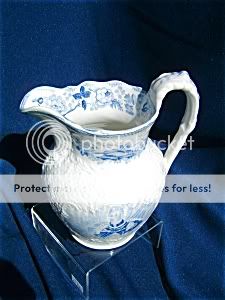 .
.
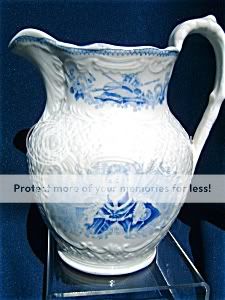
From http://www.tias.com//stores/brighton/
A large mug with the Queen and King on it
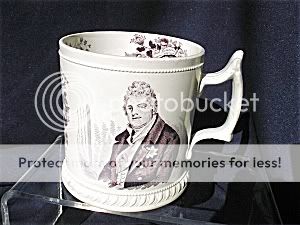 .
.
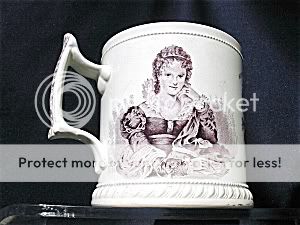 . .
. .
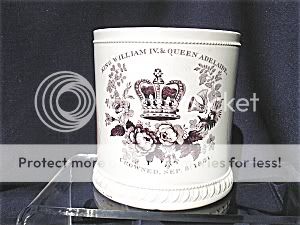 .
.
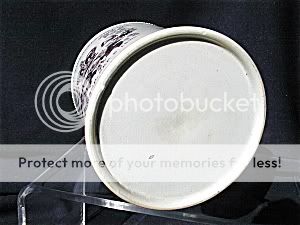 .
.
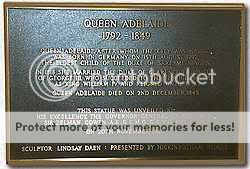
from: http://pages.theroyalpavilion.com/5103/PictPage/1922139131.html?mall=%2Fstores%2Fbrighton;itemKey=1922139131;store=%2Fstores%2Fbrighton;catId=856;itemNo=W425
Plaque in South Australia
From http://www.touradelaide.com/adel_king_william_street.html
Statue of Queen Adelaide
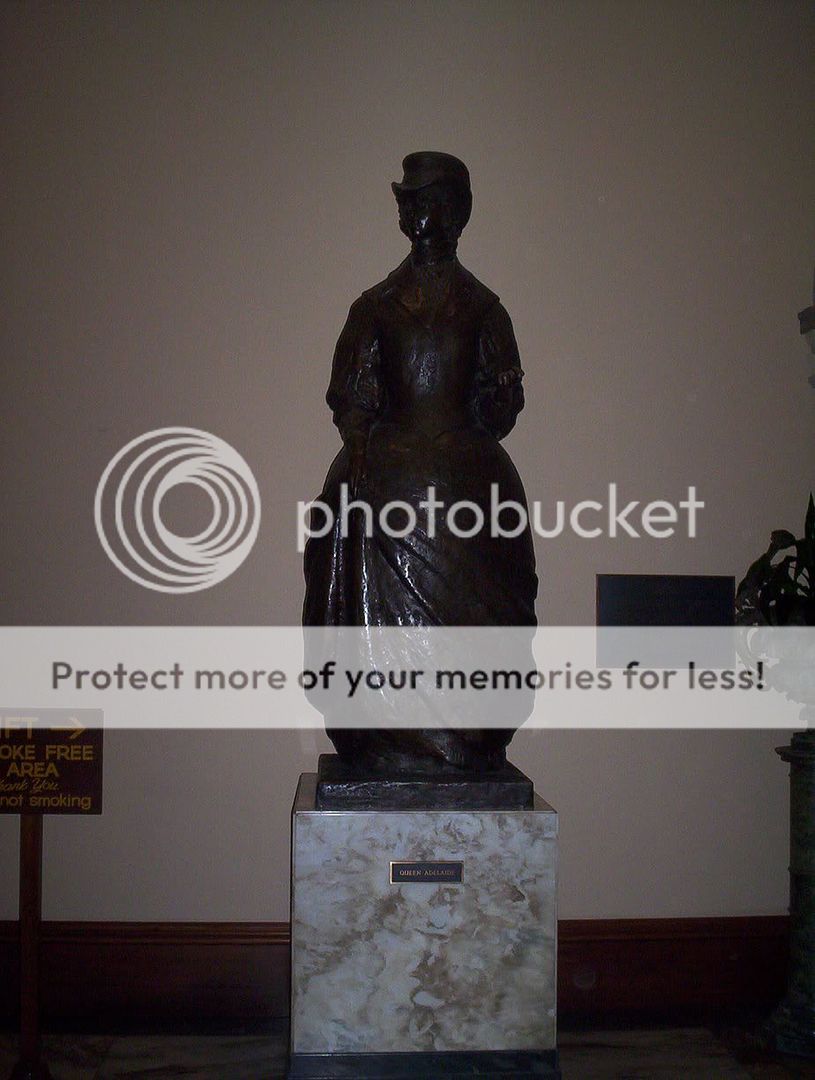
source: http://www.manuscripts.co.uk/stock/20527.HTM

ADELAIDE, Queen (1792-1849). Consort of William IV.
Large signature ('Adelaide R' with a flourish)
More Jugs, etc. with Queen Adelaide portraits



From http://www.tias.com//stores/brighton/
A large mug with the Queen and King on it





from: http://pages.theroyalpavilion.com/5103/PictPage/1922139131.html?mall=%2Fstores%2Fbrighton;itemKey=1922139131;store=%2Fstores%2Fbrighton;catId=856;itemNo=W425
Plaque in South Australia
From http://www.touradelaide.com/adel_king_william_street.html
Statue of Queen Adelaide

Last edited by a moderator:
Kotroman
Nobility
- Joined
- Jan 15, 2009
- Messages
- 468
- City
- -
- Country
- Bosnia and Herzegovina
I wonder what would have happened if, after Queen Victoria's proclamation, it was discovered that Queen Adelaide was pregnant? I assume that Victoria would have reigned until the birth of her cousin. If the child was born alive, demise of the Crown would occur (as if Victoria died) and the child would automatically become a monarch. That's because succession to the British crown is automatic and there is no interregnum whatsoever. Victoria would regain the throne only if her cousin died childless. That's how I understood the Regency Act 1830. Am I right?
However, when King Alphonse XII died leaving two daughters and a pregnant wife, his eldest daughter did not succeed and interregnum occured.

However, when King Alphonse XII died leaving two daughters and a pregnant wife, his eldest daughter did not succeed and interregnum occured.
Vecchiolarry
Aristocracy
- Joined
- Jun 25, 2005
- Messages
- 234
- City
- Calgary
- Country
- Canada
Hi,
Does anyone know how Adelaide and her sister-in-law, the Duchess of Kent got along.
I know that William IV did not get on with Victoire and vice-versa. The Duchess kept Victoria away for Court as much as possible.
Victoria and Adelaide were friendly & loving; but what about Adelaide and Victoire???
Larry
Does anyone know how Adelaide and her sister-in-law, the Duchess of Kent got along.
I know that William IV did not get on with Victoire and vice-versa. The Duchess kept Victoria away for Court as much as possible.
Victoria and Adelaide were friendly & loving; but what about Adelaide and Victoire???
Larry
Grace Angel
Nobility
- Joined
- Dec 7, 2008
- Messages
- 461
- City
- Iowa
- Country
- United States
Yes, I think that's how it would have happened if Adelaide had been discovered to be pregnant after William's death. I don't think anyone thought of that possibility though because William was very ill for some time before he died and likely wasn't up to fathering a child. I'm not sure when Adelaide's last pregnancy was. Felicia said in a post she actually had seven children that didn't live, or at least seven pregnancies. I hadn't heard that. Anyone else heard that? I thought she maybe had three or four failed preganancies/ children who died. How sad.
I'm not familiar with Spanish royal history, so can't answer your last question. But, a a rather like sitiuation could have happened in England after Henry VIII died, and left Catharine Parr a widow. Of course, Edward as first born male heir was king no matter what, but there was some thought Catharine Parr who had had no children during her marriage to Henry ( or ever) could be pregnant. But it turned out not to be the case.
I'm not familiar with Spanish royal history, so can't answer your last question. But, a a rather like sitiuation could have happened in England after Henry VIII died, and left Catharine Parr a widow. Of course, Edward as first born male heir was king no matter what, but there was some thought Catharine Parr who had had no children during her marriage to Henry ( or ever) could be pregnant. But it turned out not to be the case.
Last edited by a moderator:
iowabelle
Royal Highness , Royal Blogger, TRF Author
- Joined
- Jul 19, 2005
- Messages
- 2,403
- City
- Des Moines
- Country
- United States
I just started reading Princesses by Flora Fraser today, and it appears that Queen Adelaide did have miscarriages as late as 1835, so it wasn't totally impossible that she could have been pregnant at the same time that her husband died. Guess it was a good thing that didn't happen, would have been incredibly messy.
Similar threads
- Replies
- 2
- Views
- 523
- Replies
- 2
- Views
- 382
- Replies
- 1
- Views
- 363


